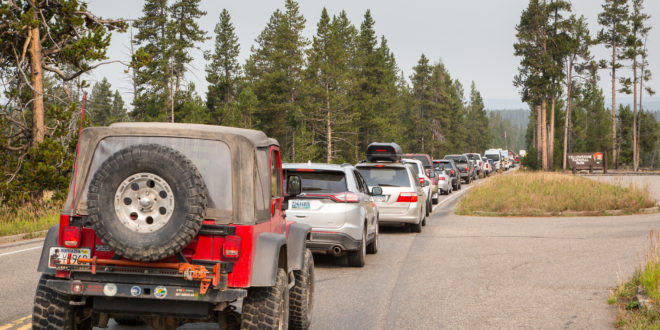With the summer season in full swing, the National Park Service is mulling visitor caps for future seasons.
According to the Associated Press/ABC News, NPS managers across the system have started considering whether to limit access to their respective parks—in light of increased interest in the national park system. Indeed, the NPS’ Centennial is expected to draw record crowds, with parks like Yellowstone expected to draw some of the largest crowds. From ABC News:
“Fundamental to the mission of the National Park Service is preservation of natural and cultural resources, social and ecological values, for the enjoyment, education and inspiration of this generation and those to come,” said Rose Keller, social scientist at Denali National Park and Preserve in Alaska.
Denali and Yellowstone plan to survey visitors about their experiences this summer, hoping the responses will provide insight on what limitations visitors might accept.
Arches and Canyonlands national parks in Utah have been taking public comment on their plans for tighter rules about how many people can be in the park at the same time. Grand Teton National Park in Wyoming should announce by the end of the year how it intends to limit access to a popular roadway.
It’s not clear how individual parks would make up for any shortfall in revenue from letting in fewer paying customers. Some parks, including Mesa Verde National Park in southwestern Colorado, already employ congestion pricing, charging more per person and per vehicle during the peak season that begins this weekend.
Last summer at Grand Canyon National Park, park managers increased entrance fees and moved lines along by dedicating an entrance gate to people who already had an annual park pass. They also promoted the use of shuttles.
Last year, of course, approximately 4.1 million people visited Yellowstone National Park, the most in Park history. 2016 may see an even larger number of people stream through the Park’s five entrances, especially by tour bus.
According to Yellowstone social scientist Ryan Atwell, speaking to AP, the larger crush of visitors saw numerous traffic jams and overflowing trash cans, along with increased pressure on Park infrastructure and the sewer system. Indeed, Yellowstone Superintendent Dan Wenk told AP the Park has seen a 60 percent increase in visitation during the first few weeks of the 2016 season. From ABC News:
If the growth continues, Wenk told a gathering of business people last week, he could envision a peak-season limit on Yellowstone visitors, albeit not for at least a decade.
“We realize that currently we’re on an unsustainable course in terms of demands for visitation compared to the ability of the current park system to handle it,” Atwell said.
Last year’s record crowds pushed Yellowstone over some thresholds as far as employee and visitor safety and propriety, he said.
In 2015, interpretive rangers gave out 52,036 resource warnings for behaviors such as threatening thermal features, approaching wildlife too closely, hiking in restricted areas and “taking bathroom breaks outside of the restroom.” That number was a 19 percent increase over the 43,558 citations issued in 2014.
From 2014 to 2015, motor vehicle accidents with injuries were up 167 percent, emergency medical transports to facilities outside the park were up 37 percent and search and rescue operations were up 61 percent, Atwell said.
In anticipation of another record year, people who plan to check out Yellowstone’s grandeur are being asked to be patient and plan ahead, respect the park, consider entering the park before 9 a.m. or after 3 p.m. to avoid larger crowds, drive responsibly and learn how to travel in bear country. Visitors are reminded to stay on the boardwalks, because hot springs have caused more injuries than wildlife. Park officials also urge visitors to “practice safe selfies” and not approach wildlife to take pictures.
Nearby Grand Teton National Park is also mulling substantive changes, including limiting the number of vehicles permitted on the 7.1-mile Moose-Wilson corridor. Under a proposed plan, only 200 cars would be permitted at a time. Wait times would have to be instituted during peak visitation hours. “What we’re trying to create and manage is the experience that you come to the Moose-Wilson to enjoy, and protect the resources of that corridor,” GT spokeswoman Denise Germann told AP.
 Yellowstone Insider Your Complete Guide to America's First National Park
Yellowstone Insider Your Complete Guide to America's First National Park





